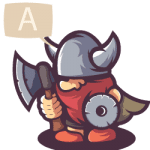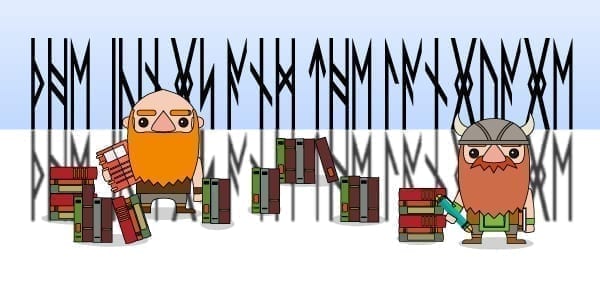There are some interesting facts in the Vikings language and history which makes it interesting for researches but also for general public. In the period from the 8th to 11th centuries, the Vikings dominated vast territories in Europe and they spread from distant parts of Russia to the east coast of North America. Their attacks were mostly conquest and religious orientated. Vikings were generally brutal, but there have been cases where they settled in a peaceful manner, creating their mark and civilization in that region.
The Vikings language and history
Advances in Shipbuilding and Navigation
 To be able to afford long trips, Vikings had a need to develop shipbuilding. This is one reason why the most striking landmark achievement is their “state of the art” technology. They were wooden objects as shallow shells, with fine wooden oars along that made the boat faster and more flexible as compared with the other ships of that time. But in the big conquest, it was not only a technological advantage that the Vikings had, but also their skill to navigate. It was exercised through the sophisticated tool, like the sun compass, which uses calcite crystals known as “sunstones”. Through it, they identified the position of the sun, even on cloudy days or at night. This was a great advantage when traveling long distances and their activity as global citizens in that time is nonrandom, even at 4 continents simultaneously.
To be able to afford long trips, Vikings had a need to develop shipbuilding. This is one reason why the most striking landmark achievement is their “state of the art” technology. They were wooden objects as shallow shells, with fine wooden oars along that made the boat faster and more flexible as compared with the other ships of that time. But in the big conquest, it was not only a technological advantage that the Vikings had, but also their skill to navigate. It was exercised through the sophisticated tool, like the sun compass, which uses calcite crystals known as “sunstones”. Through it, they identified the position of the sun, even on cloudy days or at night. This was a great advantage when traveling long distances and their activity as global citizens in that time is nonrandom, even at 4 continents simultaneously.
The Vikings Language
It is considered that the Old Norse was the Vikings language. In the 8th century, when the Vikings conquered parts of the British Isles and settled there, their influence was not just territorial but it had a big impact on the British language and culture too. Through the merger of local people and immigrant Vikings, eg. through mixed marriages, there has been a merging of some cultural values. Also, linguistic influences were observed, so old Norse is mixed with Old English.
Dublin
In the year 841 on the river Liffey, the Vikings made the first settlement on its southern coast. They had named it Dubh Linn (“Black Pool”). The area is part of the heart of present-day Dublin, and was once the center of the market for slaves in Europe. Vikings took its grip on Dublin almost for 3 centuries. In 1014 they were defeated by the Irish King Brian Boru at the Battle of Clontarf. However, the Vikings left their mark in Ireland through several Norse places names in Ireland and some Norse words in the Irish language.
Skiing
The first written references to skiing originated in China during the Han Dynasty. The oldest skis were discovered in Russia and date back to the 7th and 8th centuries BC. The word “ski” comes from the Old Norse “skío” and we definitely should be grateful that the Vikings introduced the Western tradition of skiing.
Viking Graves
Vikings were regarded as barbarians. Part of the reason is that they used various props made from animal parts and had a brutal look. They used a comb made of deer antlers that they killed. This innovation was for respect because it was not observed in other cultures around the world in that period.
Sagas
Despite the large number of artifacts that provide information about the life of Vikings, there are a number of Icelandic sagas, written by unknown authors that chronicle the Viking era in the 11th century. Information shows that in this period, the old Norsemen left their pagan gods and converted to Christianity. In Victorian era sagas were accepted as historical facts about the affairs of ordinary people and the powerful rulers. Although today’s perspective on these sources are considered historically unreliable, they represent a valuable source of information for the Vikings, decorated with mythological effects and a little imagination.
Vikings Language:
Although Vikings are considered primitive, there is an undeniable charm in their stories. Their strong suits of armor and swords give them a strong and powerful vibe, and that’s why people feel mesmerized to see them portrayed in TV shows and movies. When Vikings attacked different regions and set up their camps there, they began to integrate with local people. They married the locals, and as a result, different cultures were influenced by the values and traditions of the Vikings. 
The Vikings Language also affected the old languages. The Vikings language, also known as the Old Norse, had its impact on the languages of the local people. Wherever Vikings went, they also took with them their culture and language and changed the local culture and language for good. Such is the impact of the Vikings culture that words from the Vikings Language can still be spotted in English and Irish.
Vikings Language
The Vikings language left a significant impact on the English language. Old Norse and Norwegian words and expressions are commonplace in everyday English. The Vikings founded many towns in England, and some of them still have their original names until this day. Because of the shortage of land in Scandinavia during the 9th and 10th-century, tens of thousands of people from Denmark and Norway passed the sea and traveled to the British Isles to settle in England. Because of the immigration from Scandinavia, the Vikings language the newcomers spoke had a significant impact on the English language. It is hard to say if it was the Norwegians or Danes who influenced the English language the most as the two languages are alike. And of course, either the Norwegians or Danes speak the identical language. The language the Vikings used was called oldnordisk or translated into English Old Nordic, or as it is often referred to, Old Norse.









